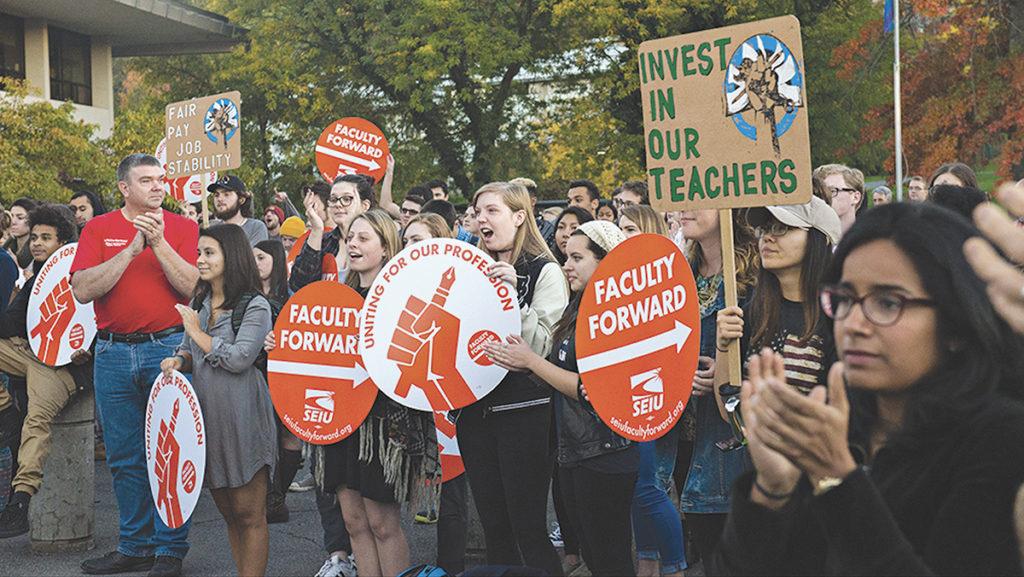At the beginning of this month, the U.S. Department of Labor released a report revealing that institutions of higher education have eliminated 650,000 jobs since February of last year. This is a 13% workforce reduction over a one-year period — a shocking devastation to those who rely on the industry for their livelihoods, as those of us on the chopping block know here at Ithaca College.
Financially, this strategy makes little sense as the elimination of dedicated faculty and staff will impoverish curriculum and student experience, while also failing to ameliorate deficits caused by the continuing COVID-19 crisis. But, as our administration likes to remind us, these problems loomed long before the pandemic’s existence. And this is true, though not in the way that they mean it: questionable management strategies in the areas of enrollment, yield and retention have made Ithaca College an outlier in the larger higher ed landscape. Whereas institutions in New York state saw, on average, a 4.1% dip in enrollment in Fall 2020, Ithaca College experienced a 17% loss in enrollment according to recent National Student Clearinghouse data.
In a very public and recent defense of their austerity plan, the president and provost insist that they “are driving systemic change that dismantles the status quo” by “interrogating systems of established power.” But their austerity measures are precisely the status quo, taken from a playbook used by countless college administrations employing corporate management styles poised to exacerbate racial, gender and class inequities and solidify power in the hands of the managerial class. Magical rebranding of austerity cuts in the guise of “Ithaca Forever” won’t change the impact that they will have on the college community.
When management tries to sell the idea that there’s just not enough to go around, a common strategy is to emphasize and exacerbate the existing campus divisions. Our college’s administrative policies, whether witting or not, rely on a divided campus from conception to implementation. The strategic plan depends upon scarcity-model tactics that split and isolate, even as it touts interdisciplinarity and inclusion in its outward-facing rhetoric. For alternatives, we can start by looking at resistance-shaped policies adopted by institutions like Hampshire College or, more recently, Oberlin College.
There is, however, a silver lining to our school’s predicament. And this comes, perhaps, from the alchemy of shared pain. Between all of the Zoom classes and department meetings and virtual committee work, between navigating childcare disasters and pandemic depression and crying with each other (so much crying), the college community has managed to find some solace in solidarity. To overcome the institutional silos that separate us. We have come to see each other again as human beings in need of, more than anything, real connection.
We should be looking to the students in these times — the brilliant, beautiful, steadfast students who are being told these cuts are being made in their names. They have taken it upon themselves to defend us — through rallies and social media campaigns and outreach that spans the country. They are fighting for their mentors, educators, friends and, in at least one case, their parents. They humble us with their confidence and vision each day, with their tenaciousness and unwavering sense of right and wrong.
To our colleagues who feel helpless in the face of these impending decisions, please realize that there is an alternative to slow death by austerity, but it must be demanded. It must be campaigned for and hard won. Resistance is not futile and power structures are not set in stone, as the recent arbitration case that was fought and won by the union against the administration demonstrates. So come out to the next AAUP chapter meeting to see how you can help or the next contingent faculty union committee meeting if you’d like a sense of agency and true shared governance. See what your remarkable peers are doing at @icopenthebooks and @icalumniagainstausterity.
And to the administration, if you’d like to participate in truly dismantling the status quo, just take the elevator down three floors, to where those students are standing out in the wind and cold and snow, asking to be heard, demanding an alternative to business as usual, and listen to what they have to say.
The IC Contingent Faculty Leadership Committee
James Miranda
Rachel Fomalhaut
Tom Schneller
John Burger
Mark Baustian














